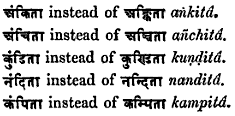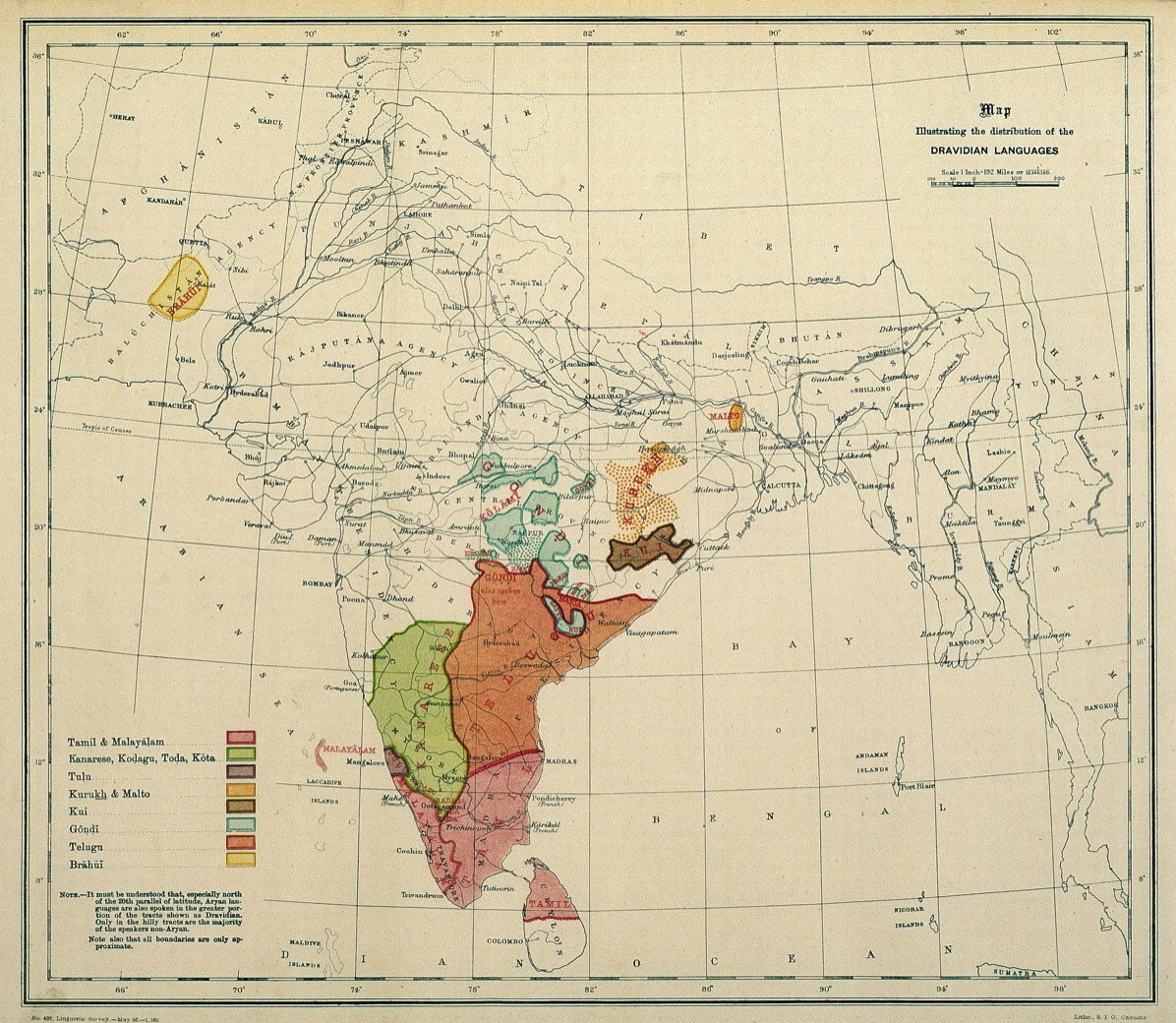|
ISO 15919
ISO 15919 (Transliteration of Devanagari and related Indic scripts into Latin characters) is one of a series of international standards for romanization by the International Organization for Standardization. It was published in 2001 and uses diacritics to map the much larger set of consonants and vowels in Brahmic and Nastaliq scripts to the Latin script. Overview Relation to other systems ISO 15919 is an international standard on the romanization of many Brahmic scripts, which was agreed upon in 2001 by a network of the national standards institutes of 157 countries. However, the Hunterian transliteration system is the "national system of romanization in India" and a United Nations expert group noted about ISO 15919 that "there is no evidence of the use of the system either in India or in international cartographic products." Another standard, United Nations Romanization Systems for Geographical Names (UNRSGN), was developed by the United Nations Group of Experts on ... [...More Info...] [...Related Items...] OR: [Wikipedia] [Google] [Baidu] |
List Of ISO Romanizations
List of ISO standards for transliterations and romanizations: Romanizations * ISO 3602:1989 (Romanization of Japanese (kana script)) * ISO 7098:2015 (Romanization of Chinese) Transliterations * ISO 9:1995 (Transliteration of Cyrillic characters into Latin characters — Slavic and non-Slavic languages) * ISO 233-2:1993 (Transliteration of Arabic characters into Latin characters — Part 2: Arabic language — Simplified transliteration) * ISO 233-3:1999 (Transliteration of Arabic characters into Latin characters — Part 3: Persian language — Simplified transliteration) * ISO 259:1984 (Transliteration of Hebrew characters into Latin characters) * ISO 259-2:1994 (Transliteration of Hebrew characters into Latin characters — Part 2: Simplified transliteration) * ISO 843:1997 (Conversion of Greek characters into Latin characters) * ISO 9984:1996 (Transliteration of Georgian characters into Latin characters) * ISO 9985:1996 (Transliteration of Armenian characters into L ... [...More Info...] [...Related Items...] OR: [Wikipedia] [Google] [Baidu] |
Hunterian Transliteration
The Hunterian transliteration system is the "national system of romanization in India" and the one officially adopted by the Government of India. Hunterian transliteration was sometimes also called the ''Jonesian transliteration system'' because it derived closely from a previous transliteration method developed by William Jones (1746–1794). Upon its establishment, the Sahitya Akademi (India's National Academy of Letters) also adopted the Hunterian method, with additional adaptations, as its standard method of maintaining its bibliography of Indian-language works. History The original precursor to the Hunterian system was a transliteration method developed by Charles Wilkins, who is sometimes called the "father of Devanagari typography" because he was also the creator of the first Devanagari typeface. William Jones, who also founded the Asiatic Society, further developed the transliteration method. It was given a more complete form in the late nineteenth century by William Wils ... [...More Info...] [...Related Items...] OR: [Wikipedia] [Google] [Baidu] |
Tahoma (typeface)
Tahoma is a humanist sans-serif typeface that Matthew Carter designed for Microsoft Corporation. Microsoft first distributed it, along with Carter's Verdana, as a standard font in the initial release of Windows 95. While similar to Verdana, Tahoma has a narrower body, smaller counters, much tighter letter spacing, and a more complete Unicode character set. Carter first designed Tahoma as a bitmap font, then "carefully wrapped" TrueType outlines around those bitmaps. Carter based the bold weight on a double pixel width, rendering it closer to a heavy or black weight. In contrast with some other sans-serif typefaces, including Arial, the uppercase "" (eye) is distinguishable from lowercase "" (ell), which is especially important in technical publications. Since 2010, Ascender Corporation has offered italic and small caps versions of Tahoma. Tahoma is often compared with Frutiger, another humanist sans-serif typeface. In an interview by Daniel Will-Harris, Carter ackno ... [...More Info...] [...Related Items...] OR: [Wikipedia] [Google] [Baidu] |
Unicode
Unicode, formally The Unicode Standard,The formal version reference is is an information technology standard for the consistent encoding, representation, and handling of text expressed in most of the world's writing systems. The standard, which is maintained by the Unicode Consortium, defines as of the current version (15.0) 149,186 characters covering 161 modern and historic scripts, as well as symbols, emoji (including in colors), and non-visual control and formatting codes. Unicode's success at unifying character sets has led to its widespread and predominant use in the internationalization and localization of computer software. The standard has been implemented in many recent technologies, including modern operating systems, XML, and most modern programming languages. The Unicode character repertoire is synchronized with Universal Coded Character Set, ISO/IEC 10646, each being code-for-code identical with the other. ''The Unicode Standard'', however, includes more th ... [...More Info...] [...Related Items...] OR: [Wikipedia] [Google] [Baidu] |
Font
In movable type, metal typesetting, a font is a particular #Characteristics, size, weight and style of a typeface. Each font is a matched set of type, with a piece (a "Sort (typesetting), sort") for each glyph. A typeface consists of a range of such fonts that shared an overall design. In modern usage, with the advent of computer fonts, the term "font" has come to be used as a synonym for "typeface", although a typical typeface (or "font family") consists of a number of fonts. For instance, the typeface "Bauer Bodoni" (sample shown here) includes fonts "Roman (typeface), Roman" (or "Regular"), "Emphasis (typography), Bold" and ''"Italic type, Italic"''; each of these exists in a variety of sizes. The term "font" is correctly applied to any one of these alone but may be seen used loosely to refer to the whole typeface. When used in computers, each style is in a separate digital "font file". In both traditional typesetting and modern usage, the word "font" refers to the delivery ... [...More Info...] [...Related Items...] OR: [Wikipedia] [Google] [Baidu] |
Gurmukhi Alphabet
Gurmukhī ( pa, ਗੁਰਮੁਖੀ, , Shahmukhi: ) is an abugida developed from the Laṇḍā scripts, standardized and used by the second Sikh guru, Guru Angad (1504–1552). It is used by Punjabi Sikhs to write the language, commonly regarded as a Sikh script, Gurmukhi is used in Punjab, India as the official script of the Punjabi language. While Shahmukhi script is used in Punjab, Pakistan as the official script. The primary scripture of Sikhism, the Guru Granth Sahib, is written in Gurmukhī, in various dialects and languages often subsumed under the generic title ''Sant Bhasha'' or ''saint language'', in addition to other languages like Persian and various phases of Indo-Aryan languages. Modern Gurmukhī has thirty-five original letters, hence its common alternative term ''paintī'' or "the thirty-five," plus six additional consonants, nine vowel diacritics, two diacritics for nasal sounds, one diacritic that geminates consonants and three subscript characters. Hist ... [...More Info...] [...Related Items...] OR: [Wikipedia] [Google] [Baidu] |
Dravidian Languages
The Dravidian languages (or sometimes Dravidic) are a family of languages spoken by 250 million people, mainly in southern India, north-east Sri Lanka, and south-west Pakistan. Since the colonial era, there have been small but significant immigrant communities in Mauritius, Myanmar, Singapore, Malaysia, Indonesia, Philippines, United Kingdom, Australia, France, Canada, Germany, South Africa, and the United States. The Dravidian languages are first attested in the 2nd century BCE, as Tamil-Brahmi script, inscribed on the cave walls in the Madurai and Tirunelveli districts of Tamil Nadu. The Dravidian languages with the most speakers are (in descending order of number of speakers) Telugu, Tamil, Kannada and Malayalam, all of which have long literary traditions. Smaller literary languages are Tulu and Kodava. There are also a number of Dravidian-speaking scheduled tribes, such as the Kurukh in Eastern India and Gondi in Central India. Outside of India, Brahui is mos ... [...More Info...] [...Related Items...] OR: [Wikipedia] [Google] [Baidu] |
IAST
The International Alphabet of Sanskrit Transliteration (IAST) is a transliteration scheme that allows the lossless romanisation of Indic scripts as employed by Sanskrit and related Indic languages. It is based on a scheme that emerged during the nineteenth century from suggestions by Charles Trevelyan, William Jones, Monier Monier-Williams and other scholars, and formalised by the Transliteration Committee of the Geneva Oriental Congress, in September 1894. IAST makes it possible for the reader to read the Indic text unambiguously, exactly as if it were in the original Indic script. It is this faithfulness to the original scripts that accounts for its continuing popularity amongst scholars. Usage Scholars commonly use IAST in publications that cite textual material in Sanskrit, Pāḷi and other classical Indian languages. IAST is also used for major e-text repositories such as SARIT, Muktabodha, GRETIL, and sanskritdocuments.org. The IAST scheme represents more than ... [...More Info...] [...Related Items...] OR: [Wikipedia] [Google] [Baidu] |
ALA-LC
ALA-LC (American Library AssociationLibrary of Congress) is a set of standards for romanization, the representation of text in other writing systems using the Latin script. Applications The system is used to represent bibliographic information by North American libraries and the British Library (for acquisitions since 1975)Searching for Cyrillic items in the catalogues of the British Library: guidelines and transliteration tables and in publications throughout the English-speaking world. The Anglo-American Cataloguing Rules require catalogers to romanize access points from their non-Roman originals. Howe ... [...More Info...] [...Related Items...] OR: [Wikipedia] [Google] [Baidu] |
Anusvara
Anusvara (Sanskrit: ') is a symbol used in many Indic scripts to mark a type of nasal sound, typically transliterated . Depending on its location in the word and the language for which it is used, its exact pronunciation can vary. In the context of ancient Sanskrit, ''anusvara'' is the name of the particular nasal sound itself, regardless of written representation. Sanskrit In Vedic Sanskrit, the anusvāra (lit. "after-sound" or "subordinate sound") was an allophonic (derived) nasal sound. The exact nature of the sound has been subject to debate. The material in the various ancient phonetic treatises points towards different phonetic interpretations, and these discrepancies have historically been attributed to either differences in the description of the same pronunciation or to dialectal or diachronic variation. In a 2013 reappraisal of the evidence, Cardona concludes that these reflect real dialectal differences. The environments in which the anusvara could arise, however, ... [...More Info...] [...Related Items...] OR: [Wikipedia] [Google] [Baidu] |
Transliteration
Transliteration is a type of conversion of a text from one script to another that involves swapping letters (thus ''trans-'' + '' liter-'') in predictable ways, such as Greek → , Cyrillic → , Greek → the digraph , Armenian → or Latin → . For instance, for the Modern Greek term "", which is usually translated as " Hellenic Republic", the usual transliteration to Latin script is , and the name for Russia in Cyrillic script, "", is usually transliterated as . Transliteration is not primarily concerned with representing the sounds of the original but rather with representing the characters, ideally accurately and unambiguously. Thus, in the Greek above example, is transliterated though it is pronounced , is transliterated though pronounced , and is transliterated , though it is pronounced (exactly like ) and is not long. Transcription, conversely, seeks to capture sound rather than spelling; "" corresponds to in the International Phonetic Alphabet. ... [...More Info...] [...Related Items...] OR: [Wikipedia] [Google] [Baidu] |
International Alphabet Of Sanskrit Transliteration
The International Alphabet of Sanskrit Transliteration (IAST) is a transliteration scheme that allows the lossless romanisation of Indic scripts as employed by Sanskrit and related Indic languages. It is based on a scheme that emerged during the nineteenth century from suggestions by Charles Trevelyan, William Jones, Monier Monier-Williams and other scholars, and formalised by the Transliteration Committee of the Geneva Oriental Congress, in September 1894. IAST makes it possible for the reader to read the Indic text unambiguously, exactly as if it were in the original Indic script. It is this faithfulness to the original scripts that accounts for its continuing popularity amongst scholars. Usage Scholars commonly use IAST in publications that cite textual material in Sanskrit, Pāḷi and other classical Indian languages. IAST is also used for major e-text repositories such as SARIT, Muktabodha, GRETIL, and sanskritdocuments.org. The IAST scheme represents more than ... [...More Info...] [...Related Items...] OR: [Wikipedia] [Google] [Baidu] |




